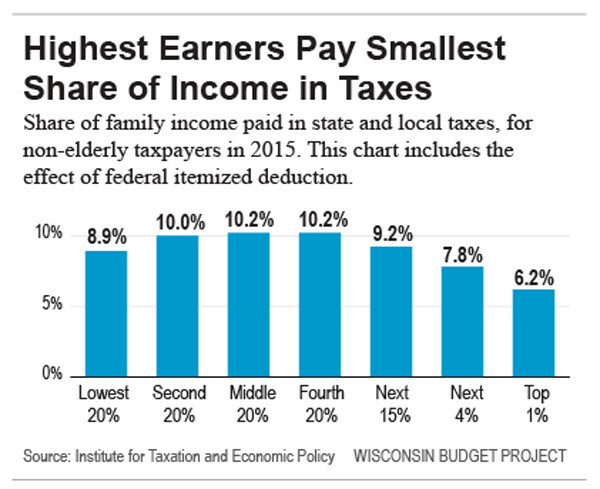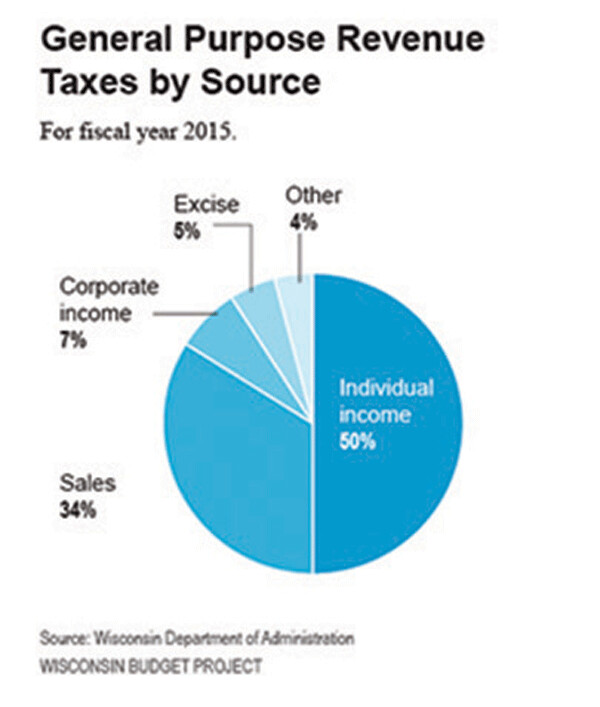Wisconsin Taxes 101
A favorite “wedge” issue of the conservatives is taxes. Everyone loves to hate taxes so it is easy to misrepresent the facts. Wisconsin is accused of being a “tax hell” with higher tax “burdens” than other states. Is this true? Of course this depends on what sources you cite and how you manipulate the numbers. Ultimately people will believe what they want to believe. This article provides some basic information on Wisconsin taxes from reputable sources to help better understand the issues.
What do Wisconsinites pay in state and local taxes?
Everyone pays taxes in one form or another. Everyone who works pays federal payroll taxes (Social Security and Medicare). Most working people also pay income taxes. Everyone who buys gasoline pays federal and state gas taxes. Everyone who owns or rents a home directly or indirectly pays property taxes. Anyone who shops pays sales taxes.
In 2013 Wisconsin residents paid an average of $6,535 in taxes, fees, and other charges to state and local governments, $118 lower than the national average (source: Wisconsin Budget Project). Keep in mind that averages can be misleading. Not everyone is paying the average. A few high or low data points can skew an average figure. Wisconsin general purpose revenue collections were $2,553 per Wisconsin resident in 2014-2015. During this period tax collections went down $117 per person (source: Forbes Magazine). Most families paid about 10% of their income in total Wisconsin taxes (see graph 1).

Is this too much? Whether taxes are too high is a subjective issue. For many conservatives paying anything is too much. But reasonable people understand that taxes are the dues we pay to live in a civilized society.
Are taxes increasing?
According to the Wisconsin Budget Project total state and local taxes dropped by 10% over the last 15 years. The Department of Revenue says, as a percent of personal income, taxes declined from 1986 to 2016.
Are taxes too high?
Wisconsin’s total state and local taxes were 2.0 percent below the national average in 2014 and ranked 18th. Wisconsin ranks higher, 16th, when taxes are measured relative to income, because personal income in Wisconsin is well below the national average (source: Wisconsin Budget Project). A Pew Charitable Trust analysis of tax “burden” puts Wisconsin at 11% with a higher than average ranking among states. Most states are in the 9-10% range. The Pew study shows that all states are relatively close to one another. Given the number of tax, fee, and policy differences between states, ranking them may not be accurate or useful.
If Wisconsin (or any government) is to accomplish its mission it must have enough revenue to do the job. The important question is whether the tax system “fair.”
Are Wisconsin taxes “fair?”
Fairness is assessed by whether taxes are progressive or regressive. Progressive taxes collect more from people with higher ability to pay. Income taxes tend to be progressive as the percentage paid goes up with income. Regressive taxes disregard ability to pay. Sales and property taxes are regressive. They hit lower income harder as a percentage of income.
Total taxes in Wisconsin are mildly regressive. Families in Wisconsin making less than $22,000 a year pay 8.9% of their income in combined sales and excise, income, and property taxes. Families in the top 1%, making $399,000 or more, pay only 6.2% (see graph 1 and 2).

In most states, including Wisconsin, the share of taxes paid by businesses (corporate income taxes) has gone down for decades. Reductions in corporate tax rates and many tax breaks have shifted the tax “burden” to individual income, property, and sales taxes. The nominal corporate income tax rate in Wisconsin is 7.9%, but many companies pay less than this percentage. A number of large, profitable companies in Wisconsin pay little or nothing in state corporate income tax.
In Wisconsin individual income taxes contribute 50% of the state’s general purpose revenue. Sales and excise taxes contributed 39%. Corporate income tax only contributed 7%. (source: Wisconsin Budget Project. See graph 3).

Another aspect of fairness is preferential tax rate on capital gains income. Wisconsin excludes 30% of long term capital gains from taxation (in addition to a 15% federal capital gains taxes rate). This means people with income from stocks, bonds, and real estate pay lower tax rates than many middle class wage earners. Most capital gains income goes to high income people.
You get what you pay for.
It is interesting that most analysis of these issues refers to taxes paid as a tax “burden.” Taxes are not portrayed as an opportunity, or investment, or responsibility of citizenship. These studies do not consider what you get for your taxes. They do not discuss the importance of the necessary services provide by government. What would you live be like without those services?
I think you would find many states that rank high in taxes also rank high in quality of life. Minnesota, Colorado, New Hampshire, Oregon are often at the top for both good places to live and higher taxes. In one ranking Wisconsin was 10th or about its rank for taxes using the Pew study. You don’t see low tax states like Mississippi, Alabama, or Arkansas described as good places to live! You get what you pay for.
The bottom line is taxes exist to raise needed public revenue. We need a fair tax system for collecting needed revenue to support the public services required of a modern society. Wisconsin could do a better job of fairly collecting needed revenue from everyone.
